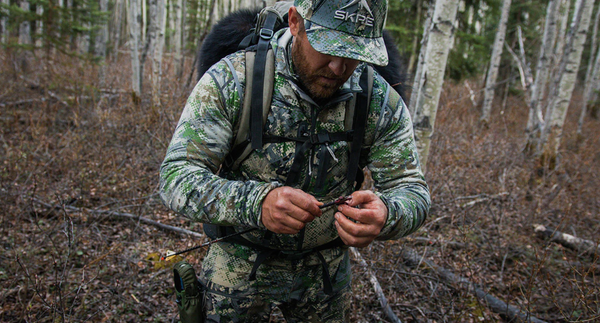Men’s Base Layer Pants 101: A Complete Guide to Choosing the Right Pair
Oct 11, 2024
When it comes to outdoor activities, comfort and performance start with your base layers. For men who enjoy hiking, hunting, skiing, or simply staying warm in cold weather, choosing the right base layer pants can make all the difference. This guide covers everything you need to know to find the perfect pair, including materials, fit, types, and tips for specific activities. Let's dive in.
Get your Base Layer Essentials
SKRE Gear® offers the best gear for you to have the most successful hunts of the season. Check out our base layer collection to stock up this hunting season.
Shop Base Layers
What Are Base Layer Pants?
Base layer pants are the foundation of an effective layering system for outdoor clothing. Worn directly against the skin, they serve as the first line of defense against the elements by regulating temperature, wicking moisture away from the

body, and keeping you comfortable in a wide range of activities.
Why They’re Important for Outdoor Activities
Base layer pants play a key role in managing moisture, retaining heat, and ensuring mobility. They can keep you dry during high-energy pursuits, warm during cold-weather outings, and even help cool you down in moderate temperatures. Whether you’re on a hunting trip or hitting the slopes, the right pair can enhance your overall experience.
Key Features to Look for in Base Layer Pants
Material Types
- Merino Wool: Known for its natural warmth, breathability, and odor resistance, merino wool is an excellent choice for a variety of outdoor activities. It’s softer and more comfortable than traditional wool, but can be more expensive.
- Synthetic Fabrics (e.g., polyester, nylon): These materials dry quickly, wick moisture effectively, and are generally more affordable than merino wool. However, they may not be as warm and can retain odors over time.
- Blended Fabrics: Some base layer pants use a blend of merino wool and synthetics, offering the best of both worlds—warmth and moisture management from the wool, with added durability and quicker drying from synthetic fibers.
If you want a base layer breakdown to see which one is the best check out this blog!
Fit and Comfort
The fit of your base layer pants affects both mobility and layering. They should be snug enough to wick moisture effectively but not so tight that they restrict movement. Look for options with flat seams to prevent chafing and elastic waistbands for comfort.
Moisture-Wicking and Breathability
Effective moisture management is crucial for base layers. Pants that wick sweat

away from your body keep you dry and prevent chills. Breathability ensures that heat can escape during high-intensity activities, helping to regulate your body temperature.
Durability
Outdoor activities can be rough on clothing. Look for base layer pants made from durable materials that can withstand regular use, washing, and exposure to the elements.
Types of Base Layer Pants
Lightweight Base Layers
- Best For: Mild weather or high-activity levels where overheating is a concern.
- Features: Thin, breathable, and quick-drying; ideal for layering under other clothes without adding bulk.
Midweight Base Layers
- Best For: Moderate temperatures or varied activity levels.
- Features: Provides a balance of warmth and breathability, making them versatile for a range of conditions.
Heavyweight Base Layers
- Best For: Extremely cold weather or low activity levels where staying warm is the primary goal.
- Features: Thicker and more insulating, perfect for low temperatures but may be too warm for high-energy pursuits.
Get your Base Layer Essentials
SKRE Gear® offers the best gear for you to have the most successful hunts of the season. Check out our base layer collection to stock up this hunting season
Shop Base Layers
Choosing the Right Base Layer Pants for Specific Activities
Hiking and Backpacking
- Key Considerations: Look for lightweight or midweight pants with excellent moisture-wicking capabilities and breathability.
- Material Tip: Synthetic fabrics can dry quickly during extended hikes, while merino wool is great for multi-day trips due to its odor resistance.

Hunting
- Key Considerations: Opt for midweight or heavyweight pants, depending on the season. Camo patterns can be an added benefit for concealment.
- Material Tip: Blended fabrics with scent control features can help you stay undetected.
Skiing and Snowboarding
- Key Considerations: Prioritize warmth and mobility. Heavyweight pants work well for colder conditions, while midweight pants are suitable for warmer ski days.
- Material Tip: Look for materials with a four-way stretch to allow for freedom of movement.
Everyday Wear and Travel
- Key Considerations: Choose versatile base layer pants that provide warmth without bulk, making them easy to wear under jeans or trousers.
- Material Tip: Lightweight merino wool blends offer comfort and odor control for long days.
Layering Tips with Base Layer Pants
Matching Base Layers with Outer Layers
- Pair your base layer pants with mid-layers (e.g., fleece pants) for extra warmth, and top it off with a waterproof or windproof outer layer to protect against the elements.
Adjusting Layers Based on Weather Changes
- Be prepared to add or remove layers as temperatures fluctuate. This strategy allows you to stay comfortable throughout the day without overheating or getting too cold.
Caring for Your Base Layer Pants
Washing Instructions
- Merino Wool: Use cold water and a gentle detergent designed for wool. Avoid fabric softeners and tumble drying.
- Synthetic Fabrics: Wash with cold or warm water and a regular detergent. Air-dry or tumble dry on low.
Drying and Storage
- Air-drying is ideal for maintaining fabric quality. When storing for long periods, make sure the pants are clean and completely dry.
Repairing Minor Damage
- Fix small rips or tears using fabric patches or repair tape. This extends the life of your base layer pants and maintains their performance.
If you want a more in depth instructions check out our blog post for Caring for Merino Wool.
Conclusion
Choosing the right men’s base layer pants involves understanding the materials, fit, and intended use. With the tips outlined above, you can make an informed decision to keep you comfortable and protected in any outdoor activity. Make sure to consider factors like moisture-wicking, durability, and warmth to find the pair that best suits your needs. Explore our recommended base layer pants at skre.ca. Stay warm and enjoy your next adventure!



